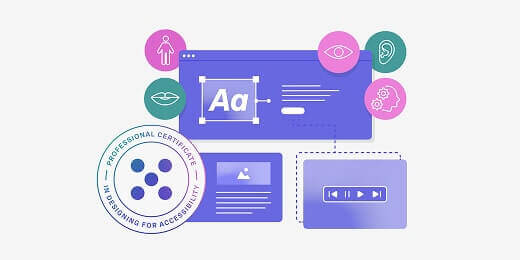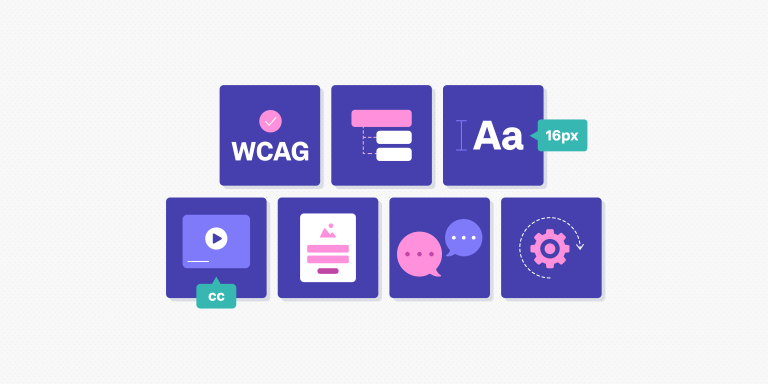The legal risks of ignoring accessibility
Digital Accessibility Standards are no longer a nice-to-have. With regulations like the European Accessibility Act (EAA) coming into force, companies offering digital products and services must now meet a strict set of requirements.
Ignore those requirements and you could face:
- Hefty fines (up to €60,000 in Ireland)
- Criminal charges and prison sentences
- Compensation claims and accessibility-related lawsuits
- Exclusion from EU markets
We cover these risks in more detail in a separate post: The legal and commercial consequences of ignoring accessibility in 2025.
How to ensure compliance and avoid penalties: practical steps
Creating more accessible digital products isn’t just a tick-box exercise. It requires a long-term commitment to accessibility, as well as continuous learning to keep up with evolving requirements and customer expectations.
So what are the most important steps to take right now? Let’s take a look.
Embed accessibility right into the product design process
Around two-thirds of accessibility issues can be prevented during the design phase, so your design process is the best place to start. Consider:
- Building an accessible design system with reusable components that follow WCAG guidelines.
- Conducting user research and testing with diverse users, including those with both temporary and permanent impairments.
- Using an accessibility checklist to guide everyday product decisions, such as ensuring sufficient colour contrast and choosing accessible font styles. We’ve compiled an accessibility checklist here which you can use to guide you.
Compliance can’t just sit with one person or team. It requires cross-functional alignment and shared accountability across the organisation.
Encourage all teams to own accessibility by:
- Including accessibility criteria in your design reviews, QA processes and release checklists.
- Defining clear roles and responsibilities for accessibility across all teams, including product, design, development and customer experience.
- Setting company-wide goals and KPIs that measure progress towards more accessible, inclusive design.
The long-term goal is to make accessibility a core part of your company culture and something that everybody feels invested in.
Equip your teams with accessibility expertise
Your first instinct might be to hire external consultants or conduct one-off accessibility audits, and those can both be valuable. But if you want to ensure long-term accessibility compliance, you must build the necessary expertise in-house.
This includes:
- Offering dedicated training for design, product and development teams.
- Appointing accessibility champions within each department to promote and advocate for best practices.
- Providing tools that can help with accessibility compliance.
The sooner you build this knowledge and expertise in-house, the less you’ll need to rely on costly rework and external capabilities. With that, let’s consider why accessibility training is so important.
Why upskilling is key for compliance and a strategic edge
If accessibility starts with design, then upskilling your design team is your most strategic move.
When teams are trained in accessibility, they’re not only able to meet compliance requirements. Even more impactful than that: they’re able to build better products. They learn how to:
- Design for a broader range of users from the start, increasing the market appeal of your product.
- Spot usability issues early, thus reducing the need for expensive rework later on.
- Ship higher-quality experiences faster and with more confidence.
That means lower technical debt and quicker time to market. It also results in more competitive products and experiences that improve customer satisfaction.
And the payoff is real. In fact, 88% of users say they’re more likely to return to an accessible website. Now that’s a major competitive advantage for your business!
Here’s the bottom line. Accessibility is becoming a non-negotiable for consumers, and prioritising it gives you a double return. When you invest in accessibility training, you not only ensure compliance with regulations like the EAA, you’re also securing your competitive advantage in terms of usability, brand reputation and customer retention.
Now is the time to prioritise accessibility training. Here’s why.
As we’ve seen, accessibility isn’t just a technical consideration. It impacts every aspect of the business and the customer experience, from legal compliance and product quality, right through to brand perception and even your talent strategy.
And, with new regulations on the horizon, not to mention rising consumer expectations, accessibility is something you can no longer afford to ignore.
Now is the time to act if you want to:
Stay ahead of regulation: The European Accessibility Act (EAA) and other global standards are tightening, and non-compliance could limit market access and pose severe legal risks.
Improve usability for all users: Accessible design often results in cleaner, more intuitive products that benefit everyone.
Attract and retain top talent: Today’s designers and developers want to work for companies that lead in inclusivity and social responsibility. Prioritising accessibility helps you stand out as an employer of choice.
Meet client expectations: Increasingly, enterprise clients expect accessibility to be built into digital products from the start, not as an afterthought. The only way to meet that expectation is to embed accessibility into your design process.
Future-proof your brand: Inclusive products build trust and credibility. They show that your organisation is forward-thinking, socially responsible and prepared to serve a diverse customer base. This is key for longevity in your chosen market.
So why prioritise accessibility training right now? You could wait, but you risk missing compliance deadlines and falling behind competitors who are already investing in accessibility. Or you can take proactive steps now to ensure legal compliance, improve the customer experience and set your business up for long-term success.
Take the next step with The UX Design Institute
You can’t outsource your way to long-term compliance. If you want to create accessible products and services and stay ahead of regulations, you need to equip your teams with the right skills and the confidence to execute.
That’s why training is so essential, and it’s why we developed our Professional Certificate in Designing for Accessibility. Built specifically for product, UX and development teams, our expert-led course helps you:
- Understand and apply key accessibility principles and best practices
- Embed inclusive thinking into every stage of the design and development process
- Build scalable, compliant and user-friendly products without slowing down delivery
Whether you’re just getting started or looking to level up your accessibility efforts, our course supports long-term capability building and hands-on implementation.
And because the course is delivered online and flexibly paced, it’s easy for teams to fit learning around their schedules and day-to-day work without compromising impact.
UX Design Institute CEO Colman Walsh introduces the new course in more detail here, and you can learn more about the curriculum via the course homepage.
The takeaway and further resources
The clock is ticking for accessibility compliance, and waiting could cost you big: legally, financially and commercially. Now is the time to act, starting with the key steps we’ve shared in this guide.
For more tools and resources, continue with the following:
- Making accessibility real: practical insights from Skyscanner’s Head of Accessibility, Heather Hepburn
- How to optimise your website for user experience accessibility
- News alert: businesses at risk of legal claims as EU accessibility deadline looms






